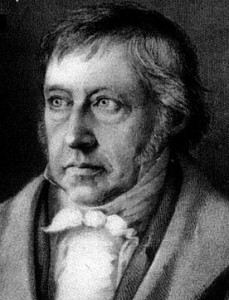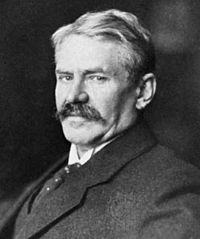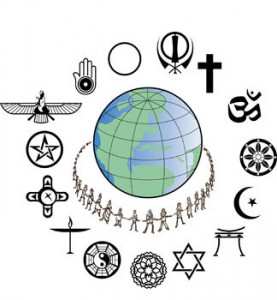While it can be said that Hegel argues for the "absoluteness" of Christianity in his narrative of the development of the "consummate" religion, Troeltsch's characterization of Christianity is not absolute, but rather "normative."
In his introduction to Lectures on the Philosophy of Religion,[1] Hegel tells us that "religion is… spirit that realizes itself in consciousness." Each realization is a two-part dynamic in which human beings are elevated to God and in which spirit realizes itself in consciousness (LPR 87/104).
 Following the steps of the dialectic, Hegel lays out the development of religion through successive stages, culminating in spirit coming to know itself completely through the process of reconciling various contradictory notions in higher and higher sublated forms.
Following the steps of the dialectic, Hegel lays out the development of religion through successive stages, culminating in spirit coming to know itself completely through the process of reconciling various contradictory notions in higher and higher sublated forms.
In this "revelatory" and "revealed" religion "God has become wholly manifest." "Everything is commensurate with the concept; there is no longer anything secret in God. Here the consciousness of the developed concept of spirit exists, the consciousness of being reconciled not in beauty, or in gaiety, but in spirit" (LPR 92, n. 8/110).
Hegel declares that the revelatory religion has appeared in the fullness of time in Christianity (LPR 92/110). For Hegel, it is no accident that Christianity has reached its full revelation in 19th century Prussia. This is the outworking of God's measured plan for the consummate religion, "religion that is for itself, that is objective to itself" (LPR 177/391).
To understand what Hegel means, it is useful to step back and consider the "finite" or "determinate" religions first. In these, God is known only as an outside force, a supreme deity that is separated from humanity. God is not mediated through consciousness.
By contrast, Hegel sees Christianity as having come to a place of fully understanding God, but also of God's having entered fully into the world through the expression of the faith. God is known and knows himself in the spirit of the Christian community that worships him (LPR 177, note 3/392).
Hegel explains that in the incarnation, Jesus Christ closes the gap between God and humanity by sublating the limits of finitude of his human person into the infinite nature of God (LPR 246, note 199/465-5). Likewise, those who follow after Christ suffer their own sort of death, only to transcend and embody God in the gathered congregation of the church (LPR 250/269).
Hegel concludes the Lectures on a note in which he claims that religion as embodied in Christianity is but one form in which absolute spirit is revealed. However, the ultimate dwelling place of spirit for Hegel is in philosophy. While the content remains the same, the forms of philosophy are more aptly suited to bear witness to the true essence of the Absolute without being encumbered by God-talk that is still too closely enmeshed with determinate forms of religion (LPR 269, note 265/488).
 In contrast to Hegel's idea of the Absolute coming to consciousness and expressing itself fully in the consummate religion, Troeltsch takes issue with the narrative structure of the dialectic which neatly lines up historical religions in a seemingly logical and interconnected sequence of events.
In contrast to Hegel's idea of the Absolute coming to consciousness and expressing itself fully in the consummate religion, Troeltsch takes issue with the narrative structure of the dialectic which neatly lines up historical religions in a seemingly logical and interconnected sequence of events.
"The doctrine that stages of development can be calculated according to a strict law—the Hegelian dialectic—has to be given up," he writes in The Absoluteness of Christianity and the History of Religions[2] (AC 100-101).
Troeltsch's argument begins by proposing that the dialectic was an attempt to get around dogmatic claims about the absolute nature of Christianity. When Christianity's miracles were compared with miracles from other religions, there was no way to arbitrate other than to make supernatural claims that do not stand up to the historical method.
Hegel and other proponents of systems of historical development thought that they had solved this problem by showing that Christianity was the evolutionary product of an advance in religions from lower to higher. Troeltsch suggests that such an argument is deficient in several ways:
- First, there is no continuity between the so-called "higher" and "lower" stages of religion. Attempts at making such continuity visible result in sloppy one-size-fits-all definitions that "do not yet fit the lower stages and no longer fit the higher" (AC 67).
- Second, Troeltsch disagrees with the idea of a universal principle of permanent value that is unveiled in historical development. He argues that such would lead to one of two conclusions. Either all religions would stream toward a single, absolute (which they do not), or it would be necessary to wait until the end of time to see what the absolute religion would look like (AC 68-69).
- Third, Troeltsch shows by tracing the historical development of Christianity that the religion has responded at various stages to historical conditions, taking characteristics from many different cultures/religions that it has come into contact with. Thus early Christianity had a strong eschatological component that it took from Judaism, but over time it has incorporated elements of Platonism, Stoicism, Aristotelianism, and finally Lutheran Reformation values of personal liberties (AC 70-71). Thus Christianity in itself is not a stable absolute, but rather has continued to change in response to the surrounding milieu.
With these factors in view, it is clear that advances have not occurred, as the dialectic would insist, in a regulated and law-like way, guided by a universal. Troeltsch's ideas are summed up then when he writes, "It must not be maintained that reality is panlogistic and monistic in character. Just as what is universally valid is not a law that calls the whole of reality into being, so evolutionary development is not mere successive realization of an idea." (AC 101)
Troeltsch continues his thought, proposing an alternative theory which he believes more accurately portrays the development of religions: "Evolutionary development means, rather, the eruption—at coexisting but discrete points—of dynamic orientations directed toward the absolute goal of the human spirit. Each orientation evolves the richness of the potential granted to it, first in its own limited sphere. At length these orientations come into contact with one another. Then in free religious and ethical encounter men take note of their gradations of value and strive to obtain a basis of judgment by drawing them together to form a philosophy of history." (AC 101)
As an alternative approach to the Hegelian method, Troeltcsh proposes a comparison of various religious accomplishments of humanity in a sort of matrix that should help us decide what religion can lay claim to being the most consummate (AC 91). He suggests that it is not necessary to know every detail of every religion, but that what is known is broad enough to map general trends (AC 92).
With this process in mind, Troeltsch sets out to identify the key moments in the development of world religions.
Ruling out all primitive religions, the narrative quickly picks up with what he refers to as religions of the law in the form of Judaism and Islam. Troeltsch characterizes these religions as inferior in their ability to "plumb the depths of the distinction between the world of the senses and the world of higher, transcendent values" (AC 109).
 From here he moves to "religions of redemption" which include Hinduism, Buddhism, and Christianity. Of these he first addresses Hinduism and Buddhism, which he finds lacking in that they concentrate on either transcending the illusion of the world of mere illusion (Hinduism) or seek to let go of the world to enter into a void of bliss (Buddhism) (AC 111).
From here he moves to "religions of redemption" which include Hinduism, Buddhism, and Christianity. Of these he first addresses Hinduism and Buddhism, which he finds lacking in that they concentrate on either transcending the illusion of the world of mere illusion (Hinduism) or seek to let go of the world to enter into a void of bliss (Buddhism) (AC 111).
Christianity, by Troeltsch's evaluation, outshines other redemptive religions because it takes seriously the transformation of both the individual and the world which is embraced and celebrated as a gift given by God (AC 112).
However, in the end Troeltsch is not ready to call Christianity absolute, but rather the normative religion to which any other contender must be compared.
Christianity is a socio-temporal outworking of conditions encountered by its adherents. As such, Troeltsch leaves open the possibility for something more: "[I]t cannot be proved with absolute certainty that Christianity will always remain the final culmination point, that it will never be surpassed" (AC 114-115).
Troeltsch is content to rest in the "absolute enough" (with a tip of the hat to my advisor, Kevin W. Hector for this formulation) nature of Christianity, leaving the final judgment open: "absolute truth belongs to the future and will appear in the judgment of God and the cessation of earthly history" (AC 115).
At the most basic level Hegel and Troeltsch share material in their narrative of historical religions. However, unlike Hegel, Troeltsch does not see a universal line of development, nor a single candidate for absolute religion. He rejects the idea of spirit working out its own consciousness within history as an attempt at providing a substitute for former dogmatic certainty. Troeltsch's judgments seem the natural outcomes of evaluating a philosophical system that would have stopped time with the culmination of absolute spirit's self consciousness.
[1] All Hegel citations in refer to Georg Wilhelm Friedrich Hegel, Peter Crafts Hodgson, and Robert F. Brown, Lectures on the Philosophy of Religion: The Lectures of 1827, One-volume ed., Hegel lectures series (Oxford, New York: Clarendon Press; Oxford University Press, 2006).
[2] All Troeltsch citations refer to Ernst Troeltsch, The Absoluteness of Christianity and the History of Religions (Louisville, Ky.: Westminster John Knox Press, 2005).
Compare Hegel and Troeltsch’s claims about the putative “absoluteness” of Christianity. To what extent do they share material and methodological commitments? To what extent do they diverge? And what, if anything, can we learn from this comparison?



